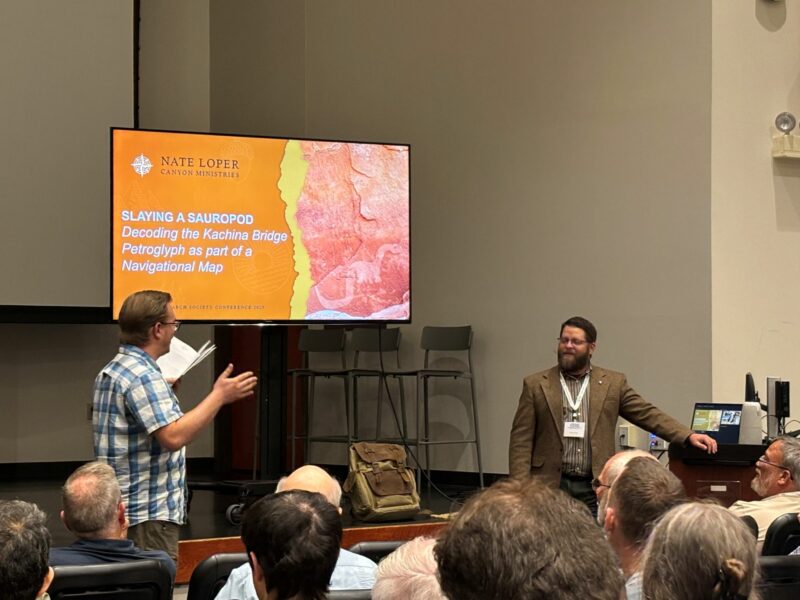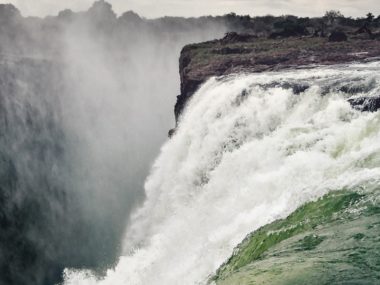From July 24th to July 26th, the annual Creation Research Society (CRS) conference found a temporary home in St. Louis, Missouri at Missouri Baptist University. Literally hundreds of creation scientists, students, and other supporters came to exchange ideas, share their research, ask hard questions, and dig deeper into untapped mysteries creation scientists have before them (and there are a lot!).
Attendees came from all across the United States, and some even came from all the way across the Atlantic! Every CRS conference is a wonderful opportunity to catch up with other creation researchers. But this year, the conference seemed particularly vibrant with new ideas, exciting research updates, and even new scientists and students who had never attended this gathering before. Between interactive workshops, technical presentations, and even field excursions related to astronomy, geology, and biology, there was never a moment for boredom!
Some of the presentations were exciting updates for ongoing research projects introduced in previous years. Others showcased novel research that aimed to tackle particular (and sometimes new!) questions within the young-earth worldview, or even propose entirely new hypotheses and models. Some even challenged popular ideas currently held by many young-earth creationists today. Presentations ranged from discussions of God’s mode of creative work during the Creation Week and soft tissue preservation in dinosaur bones, to catastrophic post-Flood mega-floods and continued research on created kinds. The New Creation team also had boots on the ground not only to attend, but also to present. Several of our writers gave presentations on their own research projects.
In this article, you can expect an overview of the highlights from each day of the conference. You will learn insights from several of the technical talks and major presentations, all of which coalesce to showcase an evolving and increasingly interdisciplinary projection of the young-earth creation research community.
Thursday: Day 1
Astronomy Workshop
Dr. Bob Hill facilitated the astronomy workshop, which consisted of several lectures interspersed with questions and discussion from the participants. Dr. Andy MacIntosh led us in a good amount of discussion over the definition of the “expanse”/“firmament” in Genesis 1. The Hebrew word behind this term—raq’ia—has had a complicated translation history. The exact referent of this Hebrew word sets the direction of any creationist model of astronomy. Wayne Spencer spoke about the assumptions we make in creation astronomy, and the need to adapt as new discoveries lead to a better understanding of the creation. He gave an example based on his own views regarding the craters on the Moon. At previous research meetings, Wayne had promoted a view that the majority of the craters on the moon resulted from impacts that occurred during the Flood. He discussed his journey from that viewpoint to his current stance, which is that most of these craters actually resulted from formative processes God used during Day 4 to create the Moon. Dr. Peter Korevaar presented several lines of argument from astronomy and cosmology that demonstrate the existence of God.
Biology Workshop
Thursday’s biology workshop was full of interdisciplinary fun. We mixed biology with engineering, computer science, and ethics. First, Mark Horstemeyer spent 15 minutes introducing “creationeering,” which seeks to identify engineering elements in biological systems such as blood vessels. Following this, Matthew Cserhati walked us through how to type functions into the RStudio program and demonstrated how he uses the program to design heat maps, which are useful for baraminology. After lunch, we gathered again to learn how to digitally study and fold proteins in 3D. Then, we took some time to discuss the “de-extinction” of the dire wolves, which we all agreed was a false story. The dire wolves were not resurrected, but rather gray wolves engineered to look like dire wolves. Finally, we had an hour-long brainstorm about the future of creation biology, moderated by Joel Brown.
Geology Workshop
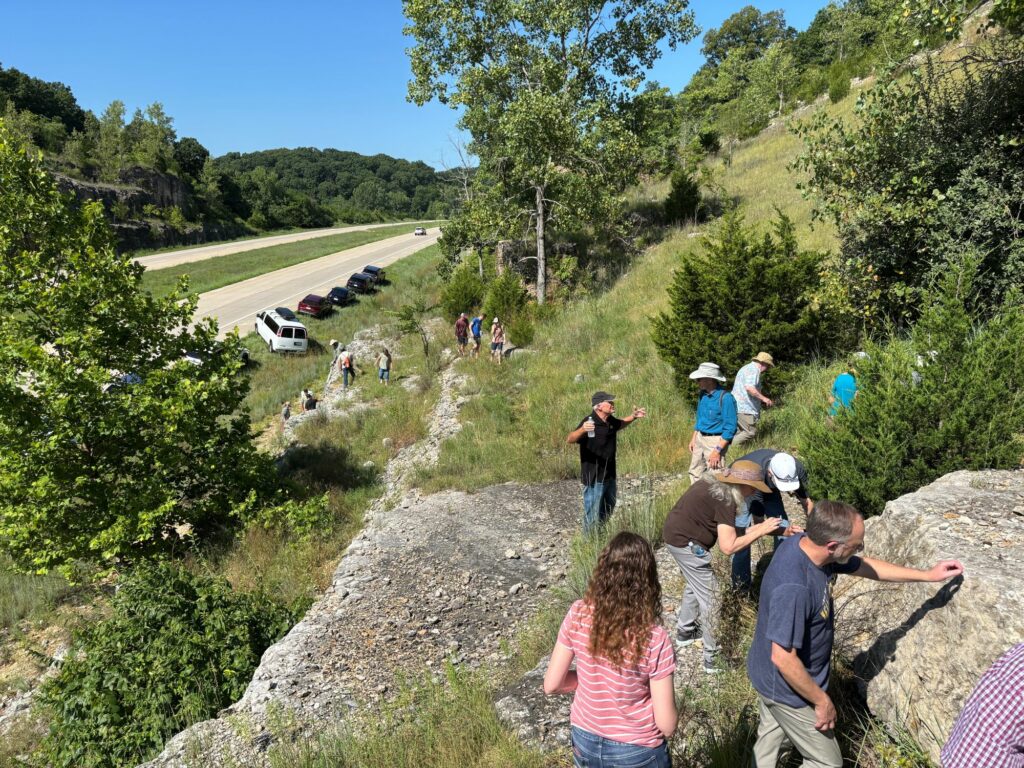
Those who were more geology inclined had the opportunity to experience two facets of geology in this workshop. From morning to lunch, Zachary Klein took the group around to multiple geologically-significant locations in the St. Louis area. The first stop was at Mastodon State Historic Site, a fossil and archaeology site dating back to the Ice Age, complete with the remains of its titular mastodon, ground sloths, giant beavers, and Clovis culture artifacts, some of which found in association with the mastodons themselves. The second stop took us even further back in time to a fossil bed of Ordovician nautiloids Klein discovered himself. The fossil site seems to have been the result of a catastrophic mudflow, similar to geologist Dr. Steve Austin’s nautiloid bed in the Grand Canyon. Finally, we stopped at a ridge composed of the St. Peter Sandstone, one of the purest known sandstone deposits in the world.
The second part of the workshop took place after lunch and was organized by geologist Dr. Tim Clarey. This was an indoor workshop where participants learned how geologists use core drilling samples to map and correlate rock layers across long distances, even regions and continents!
Friday: Day 2
Yolanda Pretorius: Proboscidea Does Not Equal the Elephant Holobaramin
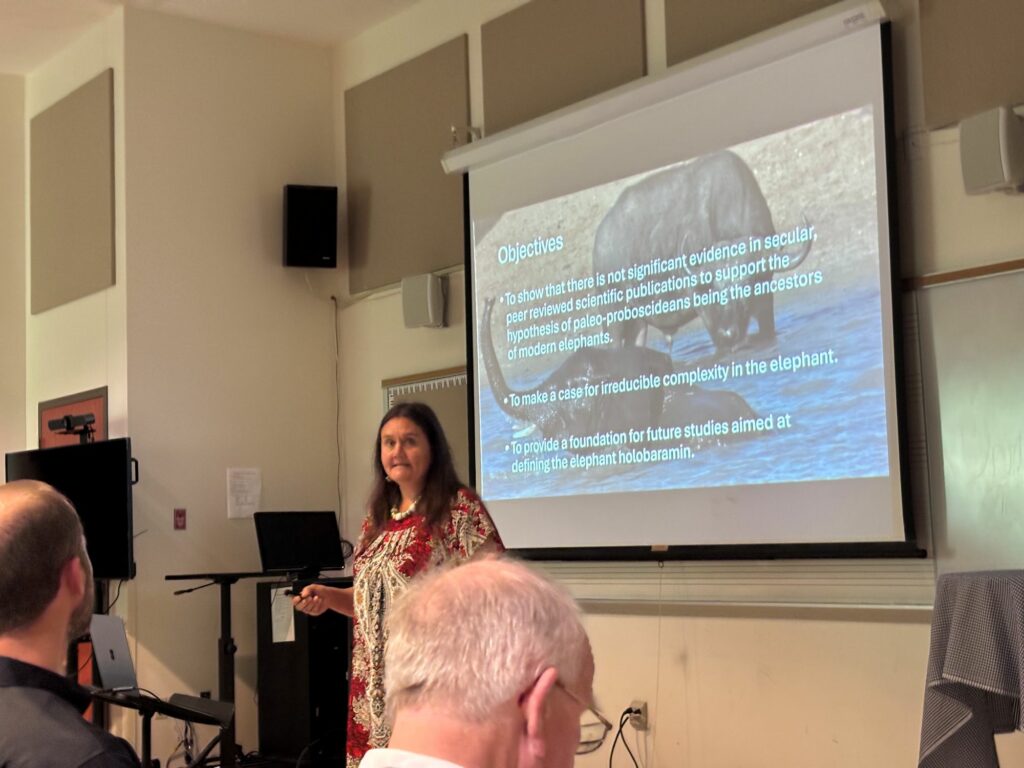
Proboscidea is the taxonomic order of mammals that contains modern African and Asian elephants, as well as mammoths, mastodons, and a variety of others. Mainstream evolutionary biologists believe that this entire group evolved from smaller, pig- or hippo-like animals with short trunks, like the dog-sized Eritherium. Likewise, many creation researchers have also argued that all species within Proboscidea belong to the same created kind. In this talk, ecological biologist Yolanda Pretorius suggests that the physical features and behaviors possessed by Elephantimorpha (the group containing just modern elephants, mammoths, mastodons, and the like) make them irreducibly complex. As such, she argues they cannot have descended from these smaller, more “primitive” forms. She also conducted a study based on the prediction that if they all belong to the same created kind, trunk development would correlate to brain growth. Her assessment of fossil Proboscideans showed no such correlation. As such, she contends that Elephantimorpha may represent its own created kind, apart from smaller, earlier Proboscidea species.
Chris Rupe: “Lucy” and the Pygmy Human Hypothesis
Lucy is a famous “apeman” skeleton found in Ethiopia. It is relatively complete, preserving parts of her head, arms, torso, pelvis, and legs. Many evolutionists believe that her species, Australopithecus afarensis was ancestral to humans. Most creationists believe that Lucy is actually just an ape. In his controversial talk, Rupe argues that Lucy is fully human. He identified skeletal evidence that she walked on her hind legs like a human, not on four legs like an ape. Rupe believes that habitual bipedality (among primates) is a uniquely human trait. So if Lucy walked upright, she must have been a human. Rupe argues that other creationists have focused on minutiae to distinguish between australopithecines and humans. He advocates for a more general approach, focusing less on anatomical details and more on the overall similarity of bones.
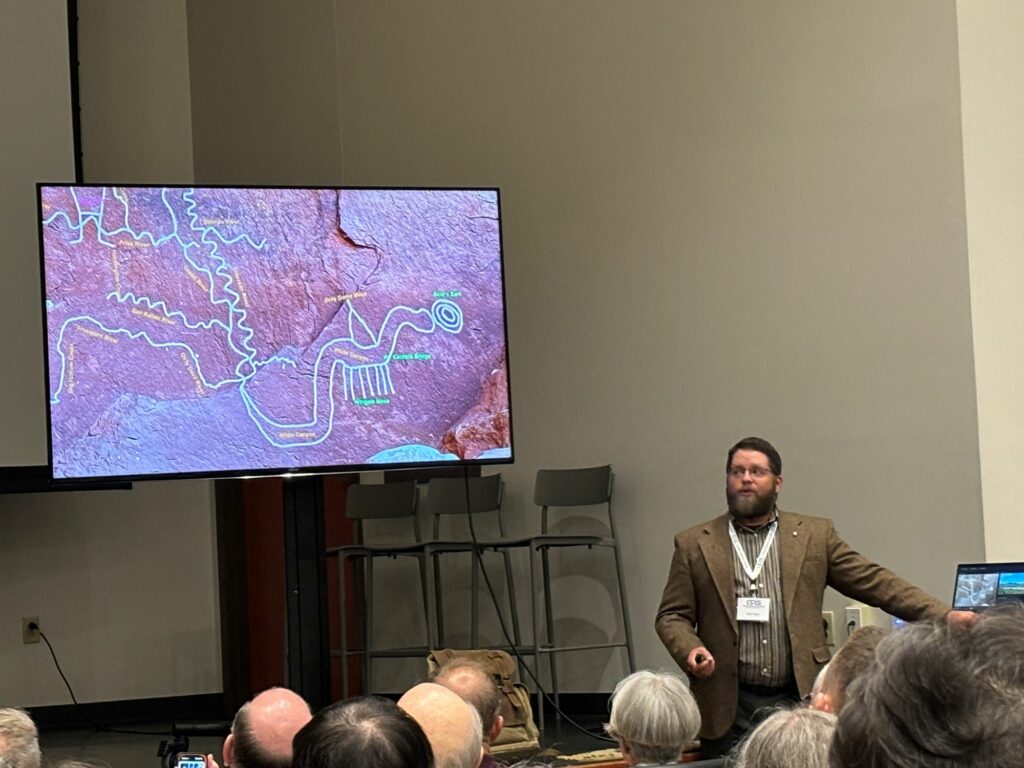
Petroglyphs are commonly found throughout Natural Bridges National Monument, in northern Utah. But one located under the naturally-formed Kachina Bridge stands out, as it appears to resemble a sauropod (long-necked dinosaur). Creationists have used it for decades to try and prove that these creatures survived well into recent historical times. However, researcher Nate Loper demonstrates many inconsistencies with this interpretation. For example, most pictures of the petroglyph in creationist books, lectures, and other media are enhanced, including the so-called “original photos.” When the actual petroglyph is examined, its likeness to a sauropod lessens significantly.
It is also worth noting that the “sauropod” petroglyph is not a single isolated petroglyph, but exists on a rock wall over 15 feet wide, overlaid with an entire network of other petroglyphs. Loper suggests that rather than portraying a sauropod, this entire petroglyph wall portrays a map marked with rivers, mountains, and even tribes inhabiting the area. The region portrayed seems to correspond to the Snake River and around 50 more real, geographical data points covering a region of around 400 miles from Idaho to Yellowstone, in Wyoming.
Zachary Klein: Tracking the Zanclean Flood: A Creation Geology Perspective on the “Largest” of the Megafloods
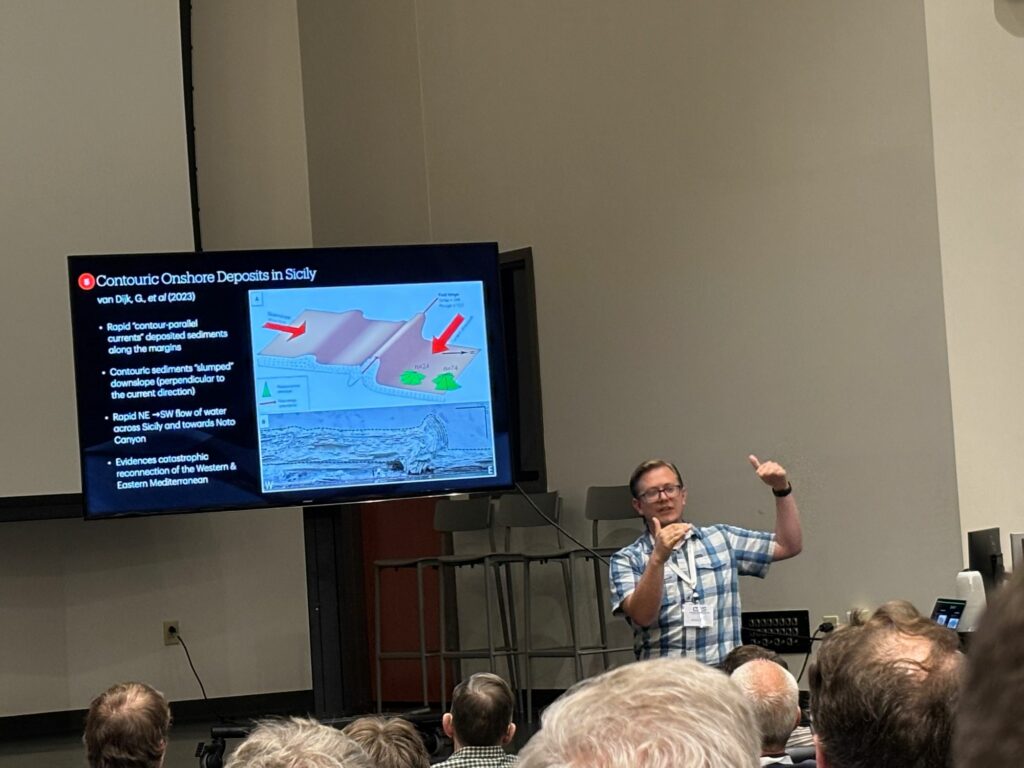
While Noah’s Flood was obviously the biggest flood in earth history, it was by no means the only mega-sized flood. Within creationist circles, we often discuss the Lake Missoula Flood and Lake Bonneville floods that ravaged much of the Pacific Northwest. According to presenter Zachary Klein, however, there may have been a post-Flood flood that was even larger: the Zanclean Flood. It is thought that the Mediterranean Sea dried out during an event called the Messinian Salinity Crisis, leaving a lowland covered in thick layers of salt. However, the Atlantic Ocean breached in a location called the Strait of Gibraltar, sending cascades of water into the Mediterranean, filling it back up.
Geologic evidence Klein cited included huge erosion channels in the western side of the Mediterranean, mega bar deposits, large sediment piles produced during the sudden influx of water, Noto Canyon, a deep underwater trench carved by the floodwaters, chaotic deposits in the Eastern Basin of dumped disorderly layers of mixed sediments, and violently broken rock fragments resulting from massive and rapid erosion.
There also appear to be references to the Mediterranean Sea not existing and then filing back up by individuals such as Pliny the Elder. This suggests the event happened much more recently than five million years ago as suggested by old-earth scientists. The Zanclean Flood plays a role in the discussion of when the Flood’s record ends and the post-Flood era begins in the geologic column. Determining the timing of the Zanclean Flood will also be important to better correlating this event with biblical history.
Andy McIntosh: Demonstration of Bombardier Beetle Spray System Applied to a Fire Sprinkler
The bombardier beetle is a creation classic. When agitated, it fires a spray system at a precise target from a twin (inlet and outlet) valve system in its body. Parallel to its digestive system is a 1mm explosion chamber filled with chemicals. It can launch this explosive defense system at an astonishing rate of 400-500 times a second. Using the beetle’s self-defense as a blueprint, Andy McIntosh and his students built a functional spray system of their own, for testing different chamber sizes, orifice sizes, and valve timings. Their long-term goal is to build an elaborate spray system that can directly target fires as they happen, instead of drenching an entire area to douse fires of all sizes. This invention would be best used in contained vehicles such as submarines, where it is costly to carry lots of freshwater but vital to avoid fire emergencies. This engineering feat would be yet another demonstration of creative design in action.
Robert Carter: Testing the ‘Genealogical Adam and Eve Model’
In 2019, Joshua Swamidass proposed the ‘Genealogical Adam and Eve Model’ to reconcile human evolution and Biblical history. In this view, he suggests that God selected two humans from an evolved human population and conferred onto them “humaneness,” or else created them from nothing but made them genetically distinct from the evolved human population. In either case, Swamidass believes Adam and Eve spread their genes through the human population, making them the genealogical (but not actual) ancestors of all living people. Their DNA, by now, would be lost and untraceable, but Swamidass maintains that all humans are genealogically descended from Adam and Eve’s original offspring.
Robert Carter developed population modeling software to test this concept, and encountered several problems with this “genealogical-not-genetic” ancestry idea. First, there is no guarantee that genealogical ancestry can impact an entire human population. Actual genetic ancestry can also last a while, and may not disappear from the population (meaning traces of Adam and Eve’s DNA would still be detectable). Physical barriers, such as geographic separation and cultural differences (i.e. regional uneven mating patterns) also posed problems to genealogical spread. Instead, within Swamidass’ own model, it is more likely that not all humans are genealogical descendents of Adam and Eve. What’s more, we are all direct descendents of Noah and his family. But, the Noahic flood is localized in Swamidass’ view, so the flood’s dramatic effect on human genetic history was left out of Swamidass’ model. In the end, the genealogical Adam and Eve model holds little merit, both theologically and scientifically.
Saturday: Day 3
Hannah Klein: Young Age Indicators in Creation Astronomy
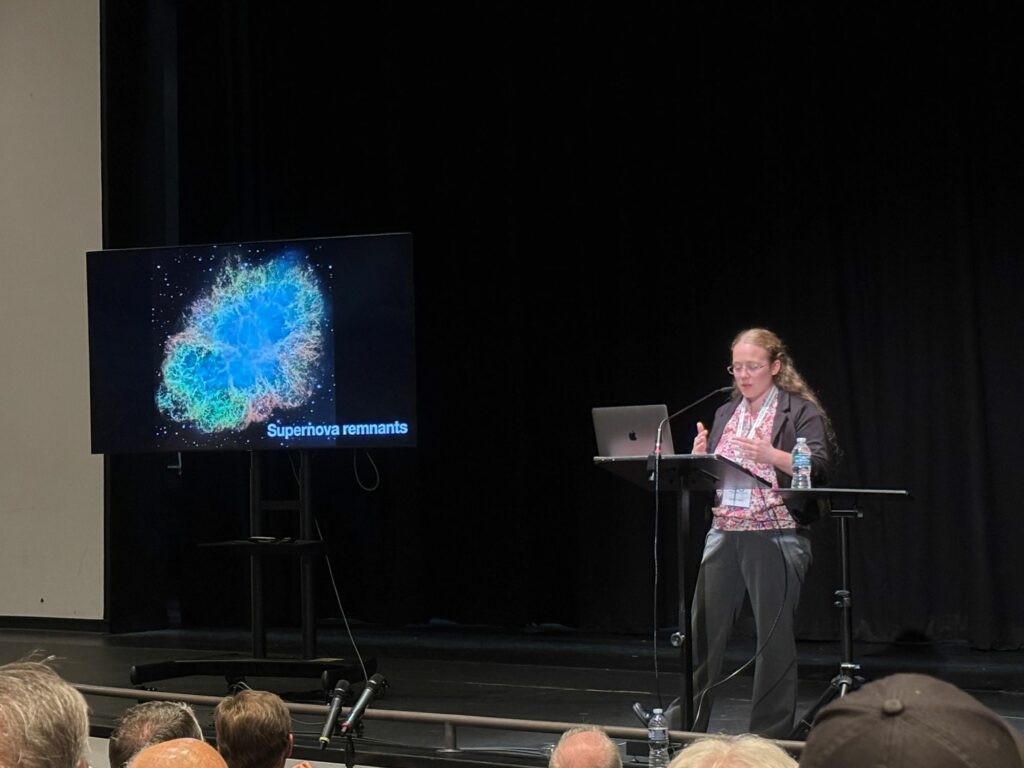
In this presentation, I (Hannah Klein) analyzed 48 phenomena used by creationists to argue for a young universe, in terms of the way we determine a young age from these phenomena. What I found is that sometimes there’s a disconnect between our arguments for a young universe and our models of creation astronomy. As an example: perhaps the most pressing question in creation astronomy is, “if the universe is around 10,000 years old, how can we see stars that are billions of light-years away?” Some very popular answers to that question involve gravitational time dilation effects, or—in other words—during Creation Week, time flowed faster in deep space than it does here on Earth. An implication of this type of cosmology is that the distant universe should appear “older” than planet Earth, since time flowed faster out there than here. But think about it—if these cosmologies are right, why are we expecting the universe to look young?
Arguments for a young age of the universe have a primary goal of disproving the Big Bang. If the Big Bang is true, the universe must appear ancient. Therefore, if we can prove the universe looks young, we can prove that the Big Bang is false. Proving the Big Bang is false is not the same thing as proving that recent creationism is true, however. In trying to disprove the Big Bang, we have to be careful that we aren’t using arguments that contradict our own models of recent creationism.
Bob Hill: Magnetocentrifugal Mechanisms for Angular Momentum Transfer And Star Formation Models
Much of creationist research has gone into critiquing opposing views, such as the Big Bang cosmology. Part of that work involves keeping up to date with the latest in evolutionary models, so we don’t run the risk of the strawman fallacy—critiques of a position that the opposing side doesn’t hold. Dr. Hill’s presentation was along these lines.
A common argument used by creationists against naturalistic star formation has to do with angular momentum. In the conventional model, stars form via the collapse of giant swirling gas clouds. Due to the conservation of angular momentum, as a gas cloud collapses, it speeds up its rotation (think how an ice skater spins faster when she pulls her arms in). The problem is that these gas clouds end up spinning way too fast as they contract, which would eventually cause the star to disintegrate. How do we get rid of the excess angular momentum?
However, as Dr. Hill demonstrated in his presentation, this argument is now out of date. Astronomers have found mechanisms by which protostars can release excess angular momentum, thus slowing down their spin rate as they develop. Dr. Hill showed us some of the current research being done on this topic, in which both theoretical calculations and observational evidence support a plausible fix for the angular momentum problem in star formation models. We need to keep up to speed with conventional research and update critiques of opposing views accordingly.
Ellie Johnston, Ryan Anderson, Faith Vandenberg & Joel Brown: Establishing Decay Rates for Bone Collagen in Different Organisms Using Fourier Transform Infrared Spectroscopy
Dinosaur fossils of the Mesozoic rock layers are all conventionally dated to be over 66 million years old. But some fossils are known to have detectable traces of collagen (the most abundant protein in vertebrates) still in them. Ellie Johnston’s presentation attempted to establish a baseline decay rate of collagen to see if it could last as long as conventional theory requires. Using a method called Fourier-transform infrared spectroscopy, the lab analyzed collagen from ground-up bone samples of mammals, reptiles, and birds. They tested how long the half-life of collagen is in each sample. The half-life measures how long it takes for a material to decay to 50% of its original size.
The researchers found that heat quickly accelerates collagen decay. So, they analyzed decay rates of collagen at 25℃ and in a neutral aqueous environment. In other words, they placed protein material in ideal conditions to last. But in the end, the half-life of mammalian collagen was found to be 1,588 years, and the half-life of avian collagen was 327 years. This means that within 10,000 years, only 1% of collagen will be left. This is only a baseline decay rate, because the conditions of the lab do not match the conditions in nature when an animal dies. But while certain natural processes may preserve collagen for longer times (such as crosslinking), ever-present microorganisms accelerate collagen decay. So, while more research is needed to simulate real-life dino collagen decay, this baseline decay rate for collagen certainly fits better with a recent death of the dinosaurs.
Jake Ramgren: A Survey of Contemporary Evolution in Nature and Its Implications to Creation Biology
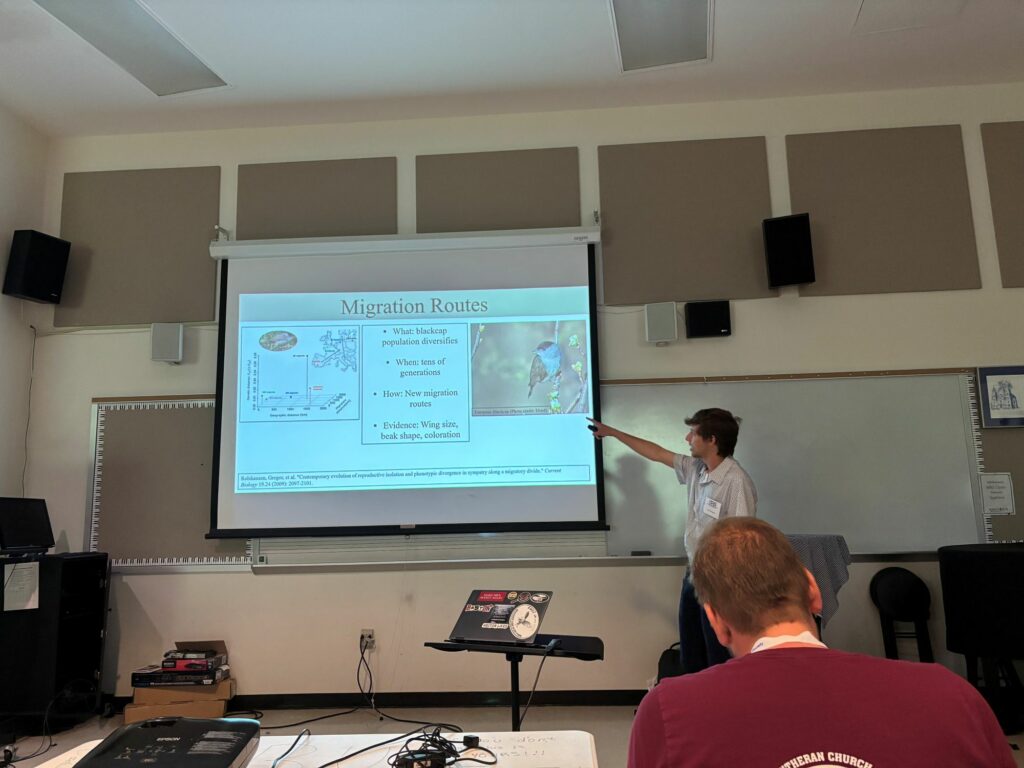
The biggest question facing creation biologists is how only two organisms of each kind on the Ark diversified into the many thousands of species we have today in only a few thousand years. If the Biblical account of the Ark is true, creationists should expect to find examples of incredibly rapid adaptation, diversification, and even speciation in animals today. In the field of conservation, scientists are finding just that. Within the last 50 years, scientists have established a phenomena called “contemporary evolution,” which is the evolution of new traits within a population in only years or decades.
Examples of contemporary evolution are wide-ranging, from tortoises on the Galapagos, to migratory songbirds in Europe, to picky cichlid fish in Lake Victoria. The conventional literature, both in fields of evolutionary biology and in conservation/ecology, is full of studies where contemporary evolution occurred. Why did it take so long for us to discover this process? Because a fundamental component of evolution is that traits evolve very slowly, through natural selection tediously removing unfit traits from populations.
While creationists struggle to find a mechanism for how species diversified from their original created kinds, they can take comfort in knowing that conventional scientists are seeking a mechanism to explain the same thing: not because their model requires it, but because they observe rapid adaptation occurring in a wide variety of animals. In short, a reasonable argument can be made for post-Flood rapid speciation even without knowing what mechanism drove it.

